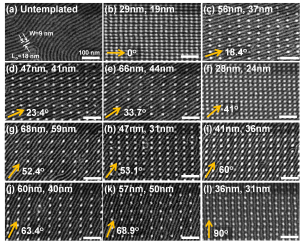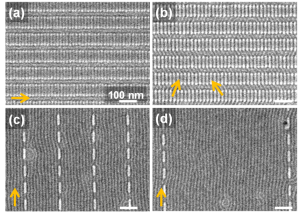Templated Self-assembly of Block Copolymer for High Throughput Sub-10-nm Fabrication
- Category: Materials, Nanotechnology
- Tags: Caroline Ross, Jae-Byum Chang, Karl Berggren
Templated self-assembly of block copolymer, based on topographic templates defined by electron-beam lithography (EBL), is an attractive candidate for next generation high-resolution lithography. Templated self-assembly has two advantages compared with other lithography methods: first, the resolution can be scaled down to 5 nm, which cannot be achieved by optical lithography; second, the throughput can be increased by several folds compared with EBL. In our previous study, complex sub-20-nm patterns were fabricated with 45.5 kg/mol poly(styrene-block-dimethylsiloxane) (PS-b-PDMS) block copolymer [1] .
Here, we demonstrate high throughput sub-10-nm fabrication by using templated self-assembly of block copolymer. To achieve 10-nm resolution, the dimensions of a block copolymer and a topographic template were scaled down to 10-nm-length scale. We used 16 kg/mol PS-b-PDMS block copolymer, which yields 9-nm half-pitch PDMS cylinders. To control the orientation of 9-nm half-pitch PDMS cylinders, rectangular lattices of posts with height of 19 nm, diameter of 8 nm, and various periods were fabricated and annealed with the block copolymer. As a result, PDMS cylinders formed a long-range ordered region when the post array satisfied the commensurate condition. By varying the periods of posts, a broad range of block copolymer lattice orientation angles was achieved (Figure 1).
On a lattice with the period larger than 72 nm, PDMS cylinders lost long-range order. To further decrease the density of the posts and therefore increase the throughput without losing long-range order, a sparse lattice of dashes was tested. As a result, a region of well-aligned PDMS cylinders with width of 708 nm was achieved (Figure 2d). The dashes occupy only 1/66 of the final PDMS line pattern. This result suggests that if instead of writing the complete pattern, EBL is used to create template arrays and the pattern is then completed by a block copolymer, the throughput of EBL could be increased dramatically.
- Figure 1: Scanning electron microscope (SEM) images of 16 kg/mol PS-b-PDMS block copolymer annealed (a) without (b)~(l) with dot-arrays. Each figure is annotated horizontal pitch, vertical pitch of template array. Scale bar = 100 nm.
- Figure 2: SEM images of PDMS microdomains templated by the dash-arrays with various horizontal pitches. The length of the dashes was 60 nm and the vertical pitch of the dashes was 100 nm. The horizontal pitch of the dashes was (a) 18 nm (b) 21 nm (c) 198 nm (d) 708 nm. Scale bar = 100 nm.
- J. K. Yang, Y. S. Jung, J. Chang, R. A. Mickiewicz, A. Alexander-Katz, C. A. Ross, and K. K. Berggren, “Complex self-assembled patterns using sparse commensurate templates with locally varying motifs,” Nature Nanotechnology, vol. 5, pp. 256-260, Mar. 2010. [↩]

